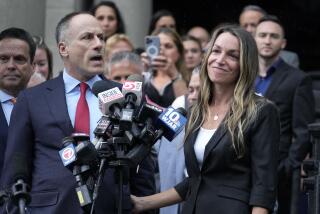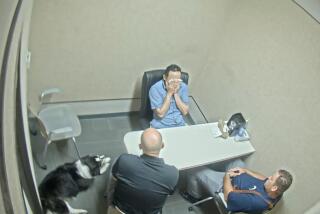Hitchhiker Testimony Out for Peyer Retrial
- Share via
Four defense witnesses whose testimony in Craig Peyer’s first murder trial suggested that an unidentified hitchhiker may have killed Cara Knott will not be allowed to take the stand in the retrial, the Superior Court judge handling the case ruled Thursday.
Judge Richard Huffman said he found no evidence connecting a “phantom hitchhiker” seen on an Interstate 15 on-ramp to the death of Knott on Dec. 27, 1986.
‘Speculation at Best’
“It is speculation at best to single out the hitchhiker from anybody else near where the victim was last seen at the gas station,” Huffman said, in ruling for the prosecution’s request. Citing a California Supreme Court case, the judge noted that defense attorneys failed to provide “direct or circumstantial evidence” linking Knott and the hitchhiker.
The ruling is likely to erode to some degree the Peyer defense because it bars attorneys from presenting the hitchhiker as an alternative suspect in the murder of Knott, who was a San Diego State University student. Prosecutors charge that Peyer, a former California Highway Patrol officer, pulled Knott over while on duty, strangled her and threw her body from an abandoned highway bridge near the Mercy Road exit on Interstate 15.
During the first trial, three young women and a retired Navy pilot testified that they saw a shabbily dressed man standing on the Escondido on-ramp that Knott used to reach southbound Interstate 15 after leaving a gas station on Via Rancho Parkway. Each witness said the man behaved very strangely, waving money at them and lunging at their cars in an apparent attempt to snare a ride.
“He jumped in front of my car, and I had to swerve to the right,” student Kim Vito testified during the first trial in February. Another witness, Ronnie Joe Hartinger, said the man “obviously was in a big rush.”
In challenging the use of the witnesses in the retrial, prosecutors argued that testimony about the hitchhiker, whom police themselves first viewed as a suspect in the murder but never found, was irrelevant.
In written arguments to the court, Deputy Dist. Atty. Paul Pfingst said presenting the hitchhiker as a suspect in the murder would be an “invitation to indulge in speculation rather than careful evaluation” of the facts.
“No jury should be encouraged to pursue unreasonable and unsupported conjecture,” Pfingst said, contending that the hitchhiker evidence would only serve to confuse or mislead those judging the case.
The prosecutor also argued that the hitchhiker was no more probable a suspect in the murder than the attendant at the gas station where Knott purchased fuel hours before her body was found.
“There is nothing relevant about this hitchhiker that could not be said about any other motorist on the highway,” he told Huffman.
Defense attorney Robert Grimes, meanwhile, countered that testimony about the hitchhiker is “extremely important” to his case because it illustrates that someone other than Peyer had the opportunity to kill Knott.
Grimes said the prosecutors’ “entire circumstantial case is built on the argument that Officer Peyer had the opportunity to commit this offense . . . and that no one else had the opportunity to do it.” He said that the defense feels “this hitchhiker testimony is essential, absolutely critical, in rebutting this elaborate set of circumstances they have created to show nobody else could have done it.”
Grimes also argued that the testimony is relevant because San Diego police investigators once viewed the scruffy hitchhiker as a prime suspect and issued an all-points bulletin asking for help in finding him.
“Then, once they arrested a suspect, as usually happens, that dampens the enthusiasm of law enforcement toward the hitchhiker,” Grimes said.
Before making his ruling, Huffman said he was unable to see why Knott would have stopped for the hitchhiker--or been forced to pull over--when other motorists successfully drove around him. Huffman also questioned why the hitchhiker was a more likely suspect than any other passer-by in the area that night.
In summarizing his decision, the judge said, “There is absolutely nothing to connect this evidence to the death of the victim.”
Grimes declined to comment on the effect the judge’s ruling will have on Peyer’s defense. But he did ask Huffman to prevent prosecutors from presenting evidence indicating that Knott was an extremely cautious person who would have stopped only for a law enforcement officer.
“We pointed out that, in the last trial, the D.A. argued quite a bit that no one else had the opportunity to get her to pull over, and we felt that was unfair, given the decision to suppress evidence about this hitchhiker lunging at cars,” Grimes said.
Huffman rejected the defense request.
Although he has lost the use of the hitchhiker as an alternative suspect in the murder case, Grimes still may call a witness who said in the first trial that she saw a woman matching Knott’s description struggling with three Latino men on the freeway shoulder Dec. 27.
Wanda Dobbie, a nurse, said she was driving south on Interstate 15 when she saw the woman standing next to a light-colored Volkswagen like Knott’s and fighting with one of the men.
Also Thursday, Huffman closed a hearing about the possible testimony of an expert witness for the prosecution, Dr. Norman Sperber. Sperber, a forensic dentist, was barred by Huffman from testifying in the first trial for reasons that are unclear because that hearing, too, was closed. In the first trial, Sperber’s dental assistant said prosecutors wanted the dentist to talk about bruises found on Knott’s face.
In rejecting a plea from an attorney for the San Diego Union-Tribune to keep the courtroom open, Huffman expressed concern that coverage of evidence introduced at the hearing but ruled inadmissible in the trial would bias jurors.
More to Read
Sign up for Essential California
The most important California stories and recommendations in your inbox every morning.
You may occasionally receive promotional content from the Los Angeles Times.













